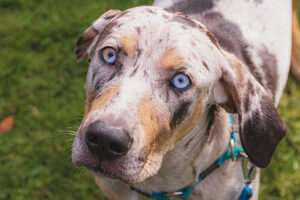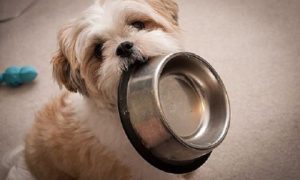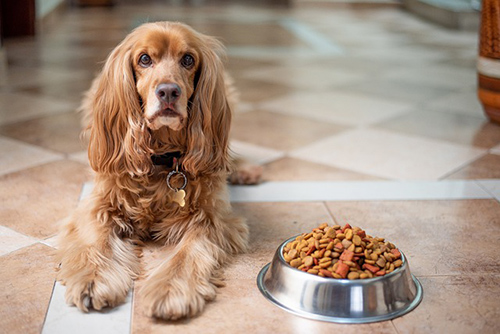
Until this time, feeding your puppy or dog was not that carefully thought-out an affair. Dogs mostly ate what we fed them and also what we left behind. Additionally, they ate what other animals left behind as well. They also killed things to eat and ate what other animals killed.

Canines are not picky eaters, as I’m sure many of us have seen a stray dog devour some form of rotting meat. Unlike cats that are obligate carnivores and cannot survive without meat, dogs are omnivores, meaning they can survive on various foods if needed.
For many generations, the unpredictable approach to feeding your puppy or dog worked well enough, specifically when a majority of dogs lived in rural areas, with easy access to rats in the barn, critters in the field, leftovers in the farmer’s kitchen, or from the slaughtering of farm animals. However, things changed, and more dogs accepted the role of companions in urban environments where living off the land was not a simple thing to achieve.
Altogether, the increasing importance of dog breeding had owners developing and refining different diets, ensuring their beloved canine companions are treated with the best food that can be supplied.
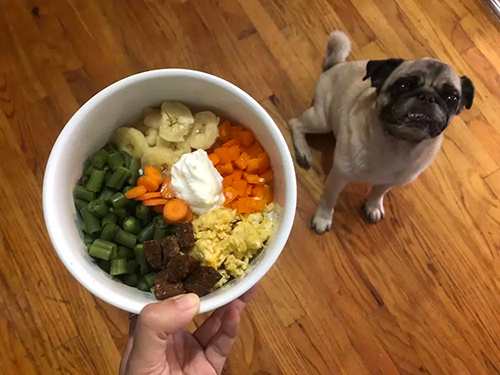
Vero Shaw’s The Illustrated Book of the Dog, first published in 1879 and reissued, as a novelty, more than a hundred years later with the title The Classic Encyclopedia of the Dog, says, “There is no doubt that a great deal of a dog’s goodness goes in at the mouth.” “We are not advocating feeding dogs only meat; we recommend that meat be incorporated into their diet along with the meal or biscuits you prefer to feed them.”
The book makes mention of the preparation and ingredients of a dog’s diet, the meticulous combining of grains such as barley and rice with vegetables such as turnip-tops, broccoli, and cabbage, along with a variety of various meats. According to the author, you can purchase fresh meat from the slaughterhouse from one pound to thirty shillings.
Today, after decades and untold hours of research from pet food manufacturers and universities, the author’s advice holds true: Today’s dogs are on a diet that is a combination of meat products and grains. What’s the difference? The pet owners of today do not find and mix ingredients. And even better, pet owners do not have to hunt and kill the occasional horse, cattle, or deer to provide meat.
The dog food industry is enormous. Americans spend billions of dollars on their canine companion’s food every year, from the most delectable meat chunks, tiny pop-lid tins, and the big bags of the least-expensive generic food.
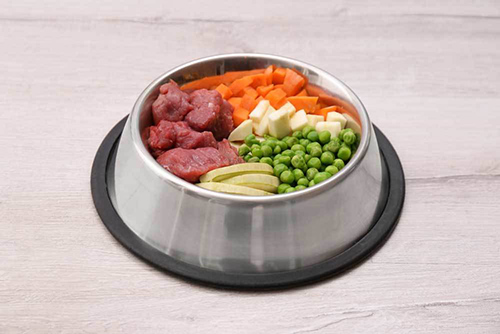
Feeding your Puppy or Dog
Feeding your puppy or dog is such a big business that some of the most influential companies today are involved. Below is a list of some of the different brands:
- Purina
- Iams (Proctor and Gamble)
- Pedigree (Mars)
- Hill’s Pet Foods, the maker of the Science Diet (Colgate)
Do some research if you still do not believe how big the industry is. I guarantee you would not have to go any further than your local supermarket or pet supply store. The pet food section takes up an enormous amount of space and at times more than any other product line. The only possible exceptions are cereals and candies that are in some cases made by the same companies. Pet supply stores sell so much pet food that they have to move inventory by forklift.
And let us not leave out veterinarians, who in many cases sell both the premium brands and the therapeutic diets designed to help your dog deal with a variety of health concerns from Kidney disease, heart disease to dental issues.
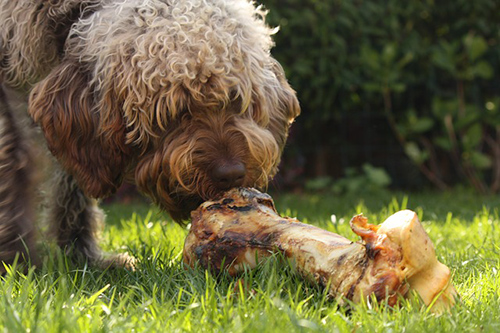
So many companies. So many places to buy. So many varieties! Where do you begin to find the right food for feeding your puppy or dog? The vital elements of nutrition found for generations in the bodies of deer, cattle, or horses? Can you find such nourishment in a can, box, or bag?
In this article, you will discover what’s known and, more importantly, what’s not known about canine nutrition. You will also find out what your dog needs and what’s being marketed directly at your desires, not your pet’s. Also, you will learn how to keep your canine companion eating correctly after choosing the right foods so that your pet doesn’t get too fat or too thin.
This information is essential, especially if you want a healthy dog with a shiny coat, bright eyes, and plenty of energy to burn. The basics of preventative health care for any animal, people, dogs, cats, you name it, is good nutrition. To provide your pet with a happy, long life, you must choose excellent nutritious food.
The Best Diet for Dogs
The leading challenge manufacturers have, is making dog food that the owner will not find too gross for their dogs to eat because what a dog would choose on their own is not what people would choose. The average dog would not turn down fresh meat; however, they would drool over a carcass further along than the human taste buds would appreciate.

For example, my dog Abe, at one time, dug into the decayed carcass of a very disgustingly dead deer. Unfortunately, I could not drag him away from it before he took a bite or two, but I got so close to the dead creature that I started gagging from the smell and sight. Although it was revolting to me, it was delicious to my dog.
Since dogs cannot purchase their own food, they’re just going to have to deal with the food people can stand to prepare for them, no rotting meat, and plenty of conveniences. Instead of the rotting deer, he’d choose, you’re going to give your dog dry food, where the label lists the first five ingredients as ground yellow corn, chicken, brewers rice, corn gluten meal, and wheat flour. On the other hand, you may decide to feed him canned food that lists brewers rice and wheat gluten just a level or two beneath turkey.
Almost all dog foods contain some variety of rice, corn, and wheat. Are dogs herbivores or carnivores? The answer to the question is they’re omnivores just like humans. They enjoy and can survive on plant or meat; however, they prefer meat. Although beef is much closer to their heart, they also enjoy treats of celery, apple, or carrots.
The right balance of convenience and nutrition while appealing to both canine and human tastes is much harder than it looks. Commercial pet food has to be deemed one of the great wonders of living in our modern times, and it continues to get better as the knowledge of good nutrition improves.
Achieving Essential Nutritional Requirements
There are various nutritional requirements (about 60) that keep your pet in optimal health, all working simultaneously to keep his body working as it should be. These nutrients play a part, and though some seem to have a more significant role than others, each is essential to keep your dog’s body in perfect working condition. Below, I will reference each of the leading canine nutrition needs.
When reading labels, you might notice that the percentages do not seem to add up to 100. That’s because the labels record the percentages of the nutritionally available food to the animal. Whatever isn’t used by the dog’s body comes out the other end as waste. Higher-quality food ingredients usually produce less to clean up in the yard.
Protein
Most manufacturers like to play up the protein content because they try to distract people from the fact that most dog food contains a lot of grains. They highlight that meat is the first and main ingredient on the label, even if they have to break down the grains into minor categories to make their relative percentages follow meat in the order of ingredients. It’s not just in the marketing; some dog food names highlight the protein in the bag.
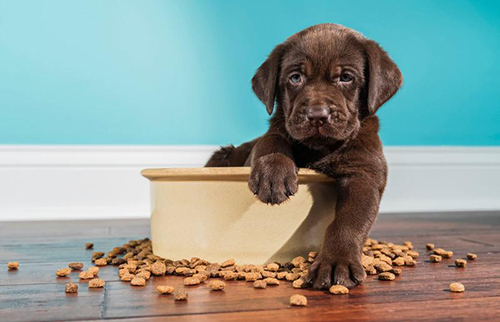
Protein is essential. However, dogs do not require as much protein as cats; dog food still contains healthy levels of protein, from 14 – 21 percent of their diet, for older dogs, to 25 – 42 percent for growing dogs or dogs that still put in full days of work, such as herding dog breeds or sled dogs.
Protein delivers the amino acids that your dog reassembles into the protein parts of his body. All animals need these life-giving nutrients. Some amino acids, known as nonessential, are produced in the dog’s body; others, called essential, must be obtained from food. Quality and variety are the most important things to remember when thinking about protein sources. A mixture of poultry, dairy products, meat, fish, and other protein sources guarantees that your dog gets all the vital amino acids he requires in his diet.
You can find protein in both animal and plant sources, and it varies in digestibility, or the amount of protein available to your dog as his body uses the food he eats. Eggs, dairy products, poultry, and meat are highly digestible and, therefore, are higher-quality protein sources. Some other parts of the animals, such as feathers, beaks, and bones, are not as digestible. Grains are in the middle when it comes to digestibility.
Carbohydrates
Carbohydrates include sugars and starches and are a source of energy. Of all the ingredients in manufactured dog foods, carbs are most likely not what a dog would choose to consume in the wild. Although they’re adaptable eaters, they take what they can find.
Canines can utilize the carbohydrates found in commercial foods, which is a good thing because, by weight, these carbs are the most significant element of most manufactured dog foods. Carbs are listed on the labels of pet foods as part of what is identified as fiber. They can take numerous forms in the list of ingredients, including soybeans, sorghum, barley, corn, rice, and beet pulp. Fiber percentages in dry food usually run from 5 – 10 percent, with purported “diet” foods on the high end of the scale.

Fats
In today’s society, we tend to worry incessantly about fat in our diets, which professionals say is too high. Dogs most often consume more fat than should be allowed. However, please do not overreact and entirely cut it out of your dog’s diet. Fats are essential to their overall health and humans too.
Fat is vital for the movement and absorption around the body of specific vitamins, the fat-soluble vitamins. Fat also provides food with much of its appeal to the canine nose and palate and with essential fatty acids, which play an indispensable role in the quality of the dog’s coat. The percentages of fat in dry dog food run from 5 percent to more than 30 percent. Diet foods have less fat, and food for growing, working, or pregnant dogs has more.
Vitamins and Minerals

Vitamins come in two categories, which are water-soluble and fat-soluble. Both types are vital to your dog’s health, and the lack of any vitamin in your pet’s diet can have severe effects. Water-soluble vitamins include B vitamins, such as niacin, pantothenic acid, biotin, choline, folic acid, and vitamin C. Fat-soluble vitamins include vitamins A, D, E, and K.
The essential nutrients your dog will need include zinc, calcium, iron, sodium, phosphorus, chloride, potassium, magnesium, and others. Just like vitamins, they make up a minor part of your canine companion’s diet; however, they’re essential for optimal health.
The most important thing to know about vitamins and minerals is that your pet needs to consume the right amount and no more. Do not take an “if a little is good, then a lot must be better” approach when it comes to vitamins and minerals. Inundating your dog with vitamins and minerals can be dangerous, which is why you should consult with your veterinarian before giving your pet supplements. Excess amounts of water-soluble vitamins are flushed out of the body with the urine; however, fat-soluble vitamins can build up to toxic levels.
Water
Good nutrition is not just about what your dog eats. Do not overlook that what your canine companion drinks is just as vital to their well-being. Clean, fresh, and ever-present water is essential to nearly every process of your dog’s body, which is, after all, composed of seventy percent water.
The smallest cells of living beings cannot live without water. Essential nutrients are transported and wastes carried away by it. Canines can go without eating for many weeks if needed; however, they can succumb in days without water.

